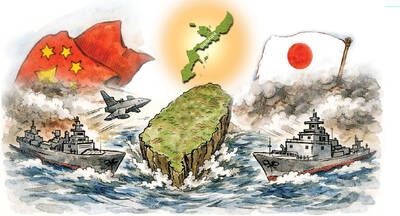An extremely rare medieval bible famous for an unfortunate error that encourages adultery has been discovered in New Zealand.
The 1631 “Wicked” Bible, as it has become known, omits the word “not” from its seventh commandment, informing readers “thou shalt commit adultery.” One thousand copies of the text, which also came to be known as the Adulterous or Sinners’ Bible, were printed, with the error only discovered a year later.
Upon discovery of the mistake, the printers Robert Barker and Martin Lucas were summoned by King Charles I and hauled before the court, where they were admonished for the scandalous typo and sloppy workmanship. They were stripped of their printing license, had a £300 fine held over their heads for years (though it was eventually quashed) and most of the texts were destroyed. Only about 20 remain in circulation.

Photo: AFP
The bibles do come up for auction from time to time mostly in Britain or US, but this is the first time one has been discovered in the southern hemisphere, says the University of Canterbury in Christchurch. The university was first informed of its existence in 2018 but chose to keep the discovery under wraps until now to allow researchers and book conservers enough time to study and preserve the book.
“It’s a mystery, it’s fascinating and it has made its way halfway around the world,” Chris Jones, an associate professor in medieval studies at the university and fellow of the Society of Antiquaries in London, said yesterday.
A former student of Jones’s brought the copy into to him in 2018 after her family had acquired it two years earlier at a deceased estate sale. The late owner was British bookbinder Don Hampshire, who moved to Christchurch from the UK in 2009, but as far as Jones can tell, Hampshire had never told anyone a thing about owning it.
Jones’s former student told him she believed it was a “Wicked” Bible, but he was “very disbelieving because these are not common items.”
“They are not things that you just walk into an office having found one in a garage in Christchurch. But I looked at it and I thought, wow, this is exactly what my former student thinks it is — it’s a Wicked Bible. I was blown away by it.”
Jones said there is a copy in Canada, some in the US, others in the UK, Ireland and “a very nice copy” in Dublin.
“The Australians claim they have one, but they don’t,” laughed Jones, adding that their copy does not contain the infamous omission of “not.”
“Having one come to me in Christchurch is just remarkable.”
The discovery of the book piqued Jones’s interest in the bible’s history and the myths about why the mistake was made, the court case surrounding it, and the printing industry more widely at that time, which he plans to publish papers on.
Debate is rife over how the misprint happened, with theories that it could have been a deliberate act of industrial sabotage by a rival printer. But Jones has panned that rumor, saying it is far more likely the printers, who were operating in a cut-throat industry, were just cutting costs on copy-editors.
The life of the New Zealand copy, which is owned by the Phil and Louise Donnithorne Family Trust, remains a mystery before it arrived in the country. Where many bibles contain detailed descriptions of family trees, dates, places and recordings of births and deaths, this copy has just one illegible name.
The copy was in relatively poor condition when it was re-discovered, with its cover missing, some water damage, and a few pages at the back gone for good. But it also has some unique features — it is one of a few copies that has the more decorative red as well as black ink and is a much more complete version that many others out there.
Book and Paper Conservator Sarah Askey has conserved the item, painstakingly treating the work, fitting a new cover and preserving it for future generations. Askey has documented any little features that could help provide clues as to where the book had been — in between some pages she found plant remnants, human hair and textile fibres.
“It was an awkward little thing to work around … and there was a lot of problem solving, but that was quite satisfying to do,” Askey said.
The book has been now fully digitized and will become free to the public via a Web site in the coming months — something Jones hopes will help shed more light on the copy’s mysterious illegible name scrawled inside.
“I’m hoping someone will come and say ‘Chris Jones, you’re an idiot, this is really obvious,’ and I look forward to it.”

Most heroes are remembered for the battles they fought. Taiwan’s Black Bat Squadron is remembered for flying into Chinese airspace 838 times between 1953 and 1967, and for the 148 men whose sacrifice bought the intelligence that kept Taiwan secure. Two-thirds of the squadron died carrying out missions most people wouldn’t learn about for another 40 years. The squadron lost 15 aircraft and 148 crew members over those 14 years, making it the deadliest unit in Taiwan’s military history by casualty rate. They flew at night, often at low altitudes, straight into some of the most heavily defended airspace in Asia.

Taiwan’s democracy is at risk. Be very alarmed. This is not a drill. The current constitutional crisis progressed slowly, then suddenly. Political tensions, partisan hostility and emotions are all running high right when cool heads and calm negotiation are most needed. Oxford defines brinkmanship as: “The art or practice of pursuing a dangerous policy to the limits of safety before stopping, especially in politics.” It says the term comes from a quote from a 1956 Cold War interview with then-American Secretary of State John Foster Dulles, when he said: ‘The ability to get to the verge without getting into the war is

Like much in the world today, theater has experienced major disruptions over the six years since COVID-19. The pandemic, the war in Ukraine and social media have created a new normal of geopolitical and information uncertainty, and the performing arts are not immune to these effects. “Ten years ago people wanted to come to the theater to engage with important issues, but now the Internet allows them to engage with those issues powerfully and immediately,” said Faith Tan, programming director of the Esplanade in Singapore, speaking last week in Japan. “One reaction to unpredictability has been a renewed emphasis on

Beijing’s ironic, abusive tantrums aimed at Japan since Japanese Prime Minister Sanae Takaichi publicly stated that a Taiwan contingency would be an existential crisis for Japan, have revealed for all the world to see that the People’s Republic of China (PRC) lusts after Okinawa. We all owe Takaichi a debt of thanks for getting the PRC to make that public. The PRC and its netizens, taking their cue from the Chinese Communist Party (CCP), are presenting Okinawa by mirroring the claims about Taiwan. Official PRC propaganda organs began to wax lyrical about Okinawa’s “unsettled status” beginning last month. A Global